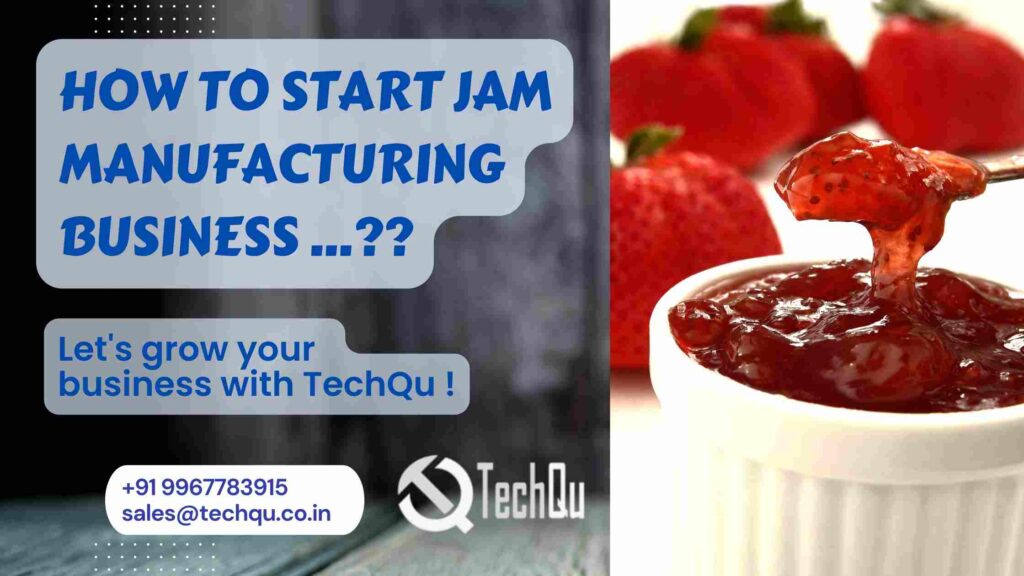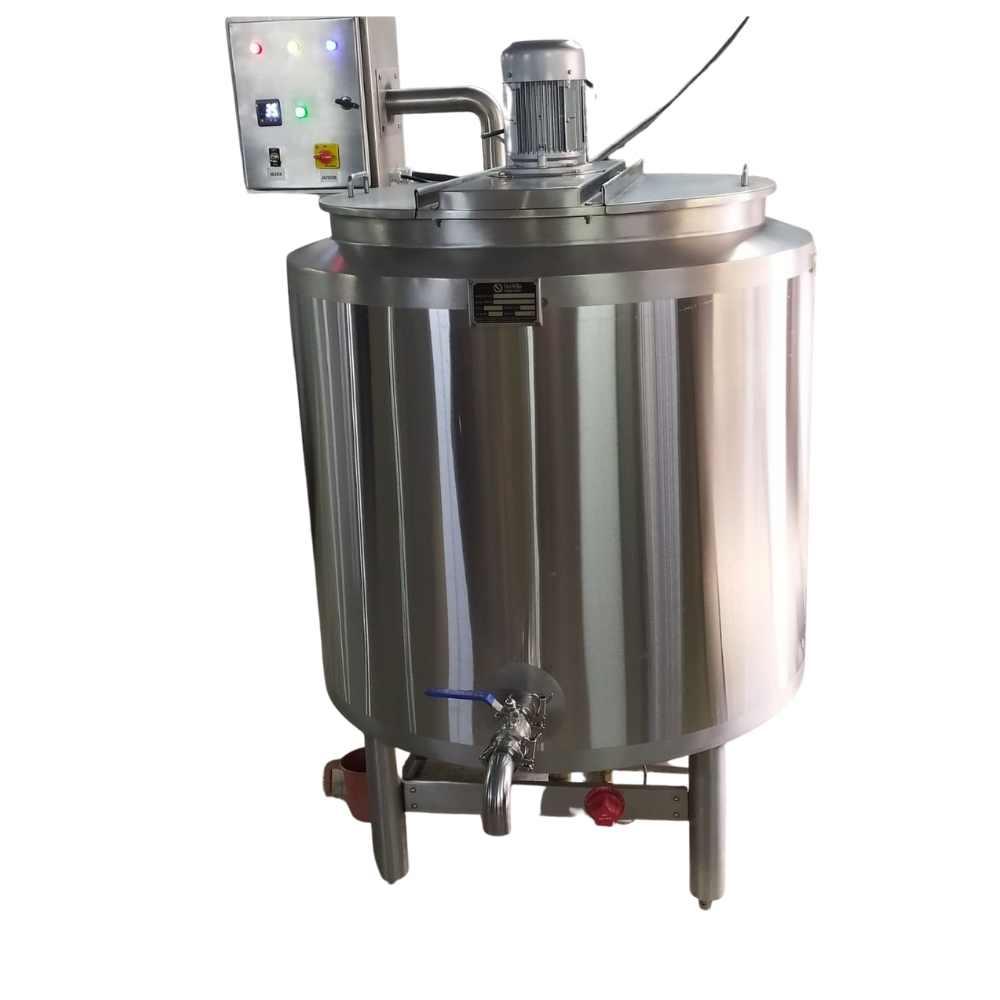What is Jam/Jelly Processing Plant ?
- Jams and jellies are spreads typically made from fruit, sugar, and pectin. Jelly is made with the juice of the fruit while jam uses the meat of the fruit as well. Jams and jellies are prepared to preserve fruits by using sugar and pectin either added from outside or which is with the fruits.
- It is a very productive activity and can give employment to the entrepreneurs in urban marketing as well as in the rural sector. Cooking jams, jellies and marmalades using fruits, sugar, pectin and edible acids is one of the oldest food preserving processes known to mankind and presents a way of making food stable by increasing the content in soluble solids.
- Jam is made from crushed or chopped fruits and sugar. Jam will hold its shape, but it is less firm than jelly. Whereas, Jelly is a semisolid mixture of fruit juice and sugar that is clear and firm enough to hold its shape.
- Generally, you can produce jams and jelly from almost every type of fruit and some vegetables. Fruit jam contains rich fruit pulp and available in mango, apple, mixed fruit, pineapple, and orange flavors. Jelly is a clear, bright mixture made from fruit juice, sugar, and sometimes pectin. Generally, people use jelly and jam as the bread spread and as a filling for some cakes and cookies.
Common Ingredients in used in Jam and Jelly
- For proper texture, jellied fruit products (fruit preserves) require the correct combination of fruit, pectin, acid and sugar.
- Fruit: Fruit gives each spread its unique flavor and color. It also supplies the water to dissolve the rest of the necessary ingredients and furnishes some or all of the pectin and acid. Good-quality, flavorful fruits make the best jellied products. Commercially canned or frozen fruit preserved in its own juice may be used to make jellied products, but pectin must be added. If you preserve your own fruit, use ¼ slightly under-ripe and ¾ fully ripe fruit. Preserve the fruit in its own juice and note how much sugar is added to allow for that in the jelly recipe.
- Pectin: Pectin is a substance in fruits that forms a gel if it is in the right combination with acid and sugar. All fruits contain some pectin, but some must be combined with fruits high in pectin or with commercial pectin products to obtain gels. Because fully ripened fruit has less pectin, one-fourth of the fruit used in making jellies without added pectin should be under-ripe. The use of commercial pectin simplifies the process, but jelly made without added pectin contains less sugar and tastes fruitier. Follow the manufacturer’s directions for using commercial pectin and do not interchange liquid and powdered pectin’s.
- Acid: The proper level of acid is critical to gel formation. If there is too little acid, the gel will never set; if there is too much acid, the gel will lose liquid (weep). For fruits low in acid, add lemon juice or other acid ingredients as directed. Commercial pectin products contain acids that help to ensure gelling.
- Sugar: Sugar serves as a preserving agent, contributes flavor and aids in gelling. Granulated white sugar is the usual type of sugar for jelly or jam. Corn syrup and honey may be used to replace part of the sugar in recipes, but too much will mask the fruit flavor and alter the gel structure. Use tested recipes for replacing sugar with honey and corn syrup. Do not try to reduce the amount of sugar in traditional recipes. Too little sugar prevents gelling and may allow yeast and mold growth. Tested recipes must be used to make jellies without added sugar, and these products usually must be stored in the refrigerator or freezer.
.
Is Jam/Jelly Processing Business Profitable?
- Jam jelly making is a profitable business. In addition, you can initiate the business on a small scale with low capital investment. The food processing industry has started receiving a great deal of attention from policymakers. The current industrial policy in food processing is also favorable for the food processing industry.
- India is the 2nd largest producer of fruits and vegetables in the world, and the food processing sector in the country is expected to double in the next decade. The ever-growing consumer demands have opened up huge investment opportunities for foreign and private entities in the food processing industry currently.
- Actually, there is already a good market for jam and jelly. And according to industry experts, the demand will grow in the near future. Some of the major reasons are the convenience of food supplement items and the preference for ready-to-eat products.
.
Seven steps to follow to start a profitable Jam/Jelly Processing business
1. Create a Business Plan
- A business plan is the key to success for any business. The required capital for starting the business is a bit high as machineries are themselves expensive. A well-crafted business plan is required to speak of the operational process of the business in a profitable manner. Legal guidelines will be strict and strong which has to be followed according to the law.
- In starting this manufacturing business, you must craft a business plan first. And for that, you must conduct a local market survey. Broadly, you will need to identify the specific types of jams and jellies that local people consume frequently. Additionally, identify the established companies in the market, their packaging, and their price. These all will help you in making decisions in your business. Your jam jelly making business plan must include:
- Executive Summary
- Company and Financing Summary
- Products Overview
- Strategic Analysis including current research
- Marketing Plan
- Personnel Plan
- 3 Year Advanced Financial Plan
- Expanded Financial Plan with Monthly Financials
- Sample Private Placement Memorandum
- PowerPoint Presentation for Banks, Investors, or Grant Companies.
- You also need to prepare a project report for arranging the finance for the set up of Jam/Jelly Plant. Broadly, you need to mention the project overview, business objective, technical aspects, project economics with cost, and marketing plan. The technical aspects contain the raw material list, production process, etc. Also, you will need to mention where you will procure the raw materials.
2. Choose a Location for Jam/Jelly Processing Business
- Find a location, where distribution cost is low. The location should be nearer to the suppliers who will supply raw materials to your plant. It also should not be too far from the immediate market where you will be supplying finished goods.
- Choosing a suitable location for your Jam/Jelly processing plant is a very important factor that can determine how successful and profitable the business grows. Selection of the right location is one of the crucial aspects of establishing fruit jam and jelly manufacturing units. Plus, individuals have to take the utilities (such as electricity, water supply, etc.) to run the company. Consider the production volume and unit size when deciding the location for the project. Generally, the specific area required depends on the unit size and production output of your project. If you want to start small, then a 1000 sq. ft. area would be sufficient. Look for a site that is within your budget.
3. Name your Jam/Jelly Processing Business
Select a name that people can relate to your Jam/Jelly processing company. Do not forget to check the availability of a similar domain name to the company name. This helps you in creating a website similar to the company name.
4. Make the Business Legally Compliant
- In starting a jam jelly making manufacturing business, you will need to register your business first. There are four options such as sole proprietorship, LLP, Pvt. Ltd and Ltd. Co. According to your management nature and objective, you need to select the right one. However, you can also start the business as a proprietorship.
- After registering the business, you will need to check the required business licenses and permissions. Depending on the location, you will need to obtain Trade License. Apply for MSME Udyog Aadhaar registration online. As jam and jelly come under the category of food product item, you will need to apply for the FSSAI License. You can register your business as an SSI Unit. Compliance with FPO and PFA Act is necessary. IS standard for these products is 5861:1970. GST Registration is a must for manufacturing businesses at present.
- There is no major pollution problem associated with this industry except for disposal of waste, Hence, you must manage it appropriately. You should apply for a “No Objection Certificate” from the State Pollution Control Board.
5. Machine & Equipment for Jam/Jelly Processing
- For a small-scale conventional production process-oriented unit you will need to have the following machinery- Pulper, Juice Extractor, Mixer, Grinder, Slicer, Cap Sealing Machine, Bottle Washing Machine, and Carton Sealing Machine.
- From this type of unit, you can expect 30 tons production output per year on 2 shift working and 300 working days
- If you want to establish a large-scale production unit you will need to establish a fully automatic production unit. According to the desired production output requirement, you can establish a customized plant.
- Additional equipment’s are needed if you want to start this at a commercial level and they are Steam Jacketed Kettle, Boiler, Miscellaneous Tools and Equipment Testing Equipment.
6. Jam Manufacturing Process
- First of all, wash the fresh fruits in water. After removing their skin, cut or slice them into small pieces. Then, boil the pieces with water. Mix the appropriate quantity of sugar with the pulp. When the temperature is around 60°C, add citric acid, color, essence, etc. This mixture is then stirred for a while, cooled, and then packed in bottles.
- The process flow chart is: Washing, peeling and slicing of fruits → Boiling → Mixing of sugar with pulp → Cooling → Packing.
6. Jelly Manufacturing Process
- Washed and peeled fruits are fed to the hopper of a juice extractor and the juice so obtained is filtered. Certain fruits like rosella or guava need to be boiled in water before extracting juice. Sugar is added to juice and then this mixture is boiled to convert it in jelly form and pectin, citric acid, colour etc. are added in the required quantity. Boiling is done till jelly-like formation is obtained. Packing is done on cooling.
- The process flow chart is: Washing and peeling of fruits → Addition of sugar in juice → Boiling → Cooling and Packing.
7. Promote your Products
- You must promote the business according to your marketing plan. The marketing plan may include promotional campaigns like offering special discounts, referrals, advertisements, new product development, etc.
- Also, you can consider packaging innovations and tie-up with buying houses. Generally, supermarkets, shopping malls, and departmental stores are the most specific locations for selling these items.
- However, you must concentrate on establishing the distribution channel. Moreover, you must put your efforts into building a regional brand at least. Also, you can consider expanding the product line along with your jam jelly production business. You can produce pickles, marmalade, squash, and fruit juices from the same unit.
- The effectiveness of distribution coverage and practice is of paramount importance in achieving the desired jam and jelly sales. Hence, understanding the distribution channels is crucial for the manufacturer to plan and implement an effective distribution strategy. So, you must provide extra emphasis on building a potential distribution network.
- Additionally, you can gain market share through enhancing retailer, and distributor margins. Finally, you can consider utilizing the media like broadcasts, newspapers, and also social network platforms to introduce the products and also attract more customers.
Explore
Related Products







